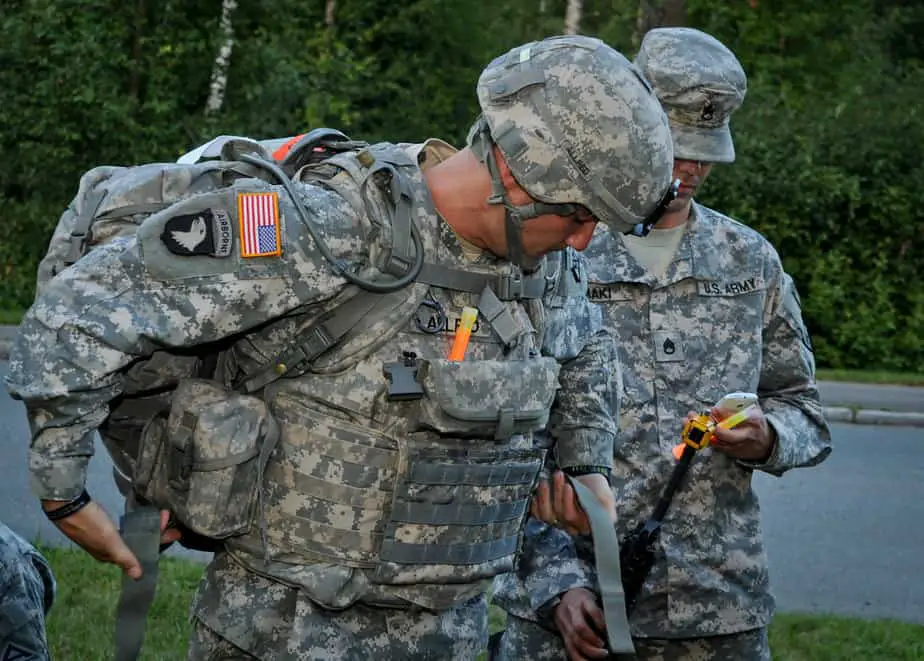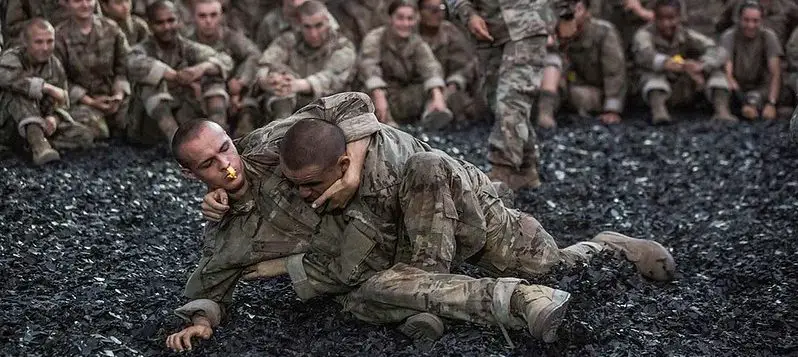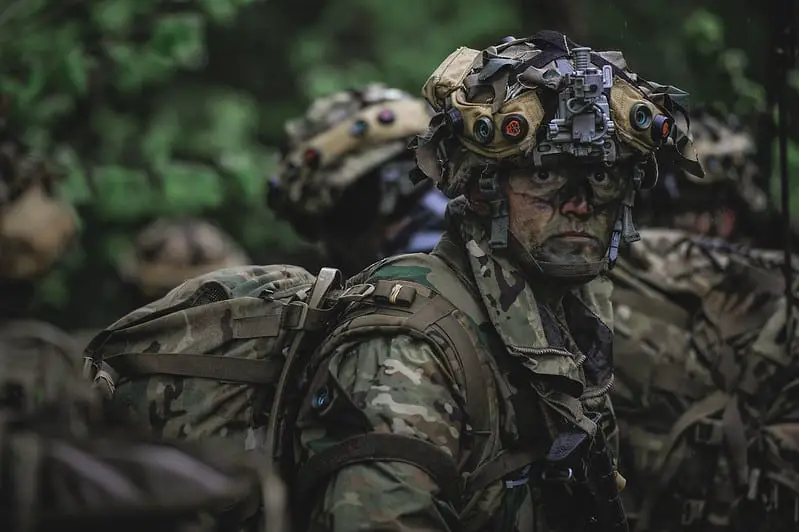
In the United States Army, weighted marching or ‘rucking’ is a staple of military drills and training. All recruits are expected to complete successful ruck marches: long journeys made on foot while carrying a heavy weight in a rucksack. There are many reasons for this, not least of which are rucking’s benefits for stamina, strength and muscle tone.
Did you know that searches for “rucking” has increased by 50% globally in April of 2023 compared to the previous year? Check out my full study on The Rise of Rucking: Investigating the Growing Popularity of Rucking
From a fitness perspective, army ruck march standards are very high. Yet, there’s also a psychological aspect of this training that shouldn’t be overlooked. It takes more than just strength to beat the US Army’s target of 12 miles (19 kilometers) in three hours. Mental fortitude is a key part of this test. Often, the most skilled ruckers are those with high levels of mental fortitude and a positive mental attitude. Learn more about how to ruck march faster here.
12 Mile Army Ruck March Standards
In the military, supervised ruck marches are a key part of infantry testing. Recruits must complete all weighted marches to the standards set by the Expert Infantryman Badge. The EIB is a special skills badge which has been awarded to infantrymen for ruck marching and related training challenges since 1943.
Ruck march rules are established and maintained by the EIB. Personnel awarded with the EIB determine the length of marches (always 12 miles) and the weight of rucksack carried. If recruits do not cover this much ground with a weight equal to or exceeding thirty-five pounds, they are disqualified and do not receive a skills award.
On a standard military ruck, participants march along a circular route. After twelve miles, they end up back where they started. Unless rehearsing for combat in a specific type of environment, the chosen terrain is relatively level and even. As rucking isn’t a test of orienteering skills, the route is clearly marked with flags, poles or signs. With all that said though, how much weight are soldiers carrying during their marches?
Well, that depends. When soldiers are in combat, the army commanders and their subordinate leaders need to make a difficult decision. They need to make sure that the soldiers are carrying all their essential equipment to complete the mission successfully, but at the same time they need to ensure that the soldier is not overworked and carrying too much weight because that can lead to exhaustion or potential injuries.
Army leaders need to decide between different combat loads to find the perfect balance between soldier effort and completing the mission unbeaten.
There are three types of combat loads a recruit must carry on their march depending on the commanders decision:
- Fighting Load
- Approach March Load
- Emergency Approach March.
Combat Loads is when the soldier demands minimum equipment to operate and survive on the designated mission. The soldiers load is transported sustainment and contingency loads.
If you think the US military ruck march standard is tough, learn more about the Norwegian Ruck March which is a challenge for most soldiers.
Fighting Load

The fighting load requires the soldier to carry all of his or her needs to defeat the enemy. These missions are critical and therefore the soldiers’ load is heavy. However, its not too heavy for the soldier as they need speed and agility to complete their mission successfully. The table below is a list from the US military Foot March Publication.
| Fighting Load | Pounds |
|---|---|
| Army Combat Uniform (T-shirt, socks, boots, belt, patrol cap) | 7.8 |
| Advance combat helmet | 4.2 |
| Field load carrier (FLC) | 5.8 |
| Knee pads | 0.5 |
| M4 (no magazine) | 6.4 |
| 5.56 unit basic load (UBL; 210 rounds and 7 magazines) | 7.0 |
| Advanced Target Pointer Illuminator Aiming Light | 0.5 |
| M68 (Close Combat Optic) | 0.9 |
| AN/PAS-13(V)1 (LWTS) | 1.9 |
| AN/PVS-14 (MNVD) Includes helmet mount | 1.2 |
| Soldier Plate Carrier System (SPCS) | 5.9 |
| Small Arms Protective Inserts (front and back), Side Ballistic Insert | 16.0 |
| 1 Quart canteens (2 each, with water) | 4.6 |
| Meals ready to eat (MRE) | 1.4 |
| M67 fragmentary grenades (2 each) | 2.0 |
| Compass | 0.5 |
| Bayonet w/scabbard | 1.3 |
| Individual first aid kit | 1.0 |
| Total | 68.9 |
Learn more about how many calories are in an MRE.
Approach March Load

The approach march load is where direct contact with the enemy is in motion. This not only demands the soldier to carry the fighting load, but an assault pack or rucksack with more things to carry. The goal here is is to allow the soldiers to fight and sustain themselves until they are resupplied. The load is heavy, but its capped at 100 pounds to avoid impeding the soldiers’ ability to fight. See the list below of items typically held on a Approach march load.
| Approach March Load | Pounds |
|---|---|
| Assault Pack | 3.1 |
| T-Shirt | 0.2 |
| Socks (2 pairs) | 0.4 |
| Wet weather top and bottom | 3.0 |
| Poncho | 1.0 |
| Poncho liner | 1.5 |
| Weapons cleaning kit | 1.0 |
| Entrenching tool with carrier | 3.5 |
| 2-quart canteens (2 each) | 10.0 |
| Meals, ready to eat (3 each stripped) | 4.2 |
| Subtotal | 27.9 |
| Add Fighting Load | 68.9 |
| Total | 96.8 |
Emergency Approach Loads
Emergency approach loads are used less frequently on ruck marches. They contain heavy items that cannot be transported by vehicle due to issues with impassable terrain. When they are used for drills, the distance travelled is often shorter than the standard twelve miles. Similarly, sustainment loads – containing equipment needed for overnight missions – are used infrequently to prepare soldiers for longer excursions.
It should be noted military recruits are not expected to be naturally adept at this kind of weighted walking. They build their skills gradually with progressively heavier marches and weight training programs designed to increase muscle in the lower back, legs and upper body.
As a general rule, 5-10 lbs get added to a trainee’s rucksack weight every two or three weeks. Military recruits train for both slow marches and quicker marches that require a cadence similar to jogging.
Learn more about what does a soldier carry going in his backpack going into battle here
Personal Items Carried
The army issues soldiers so much items to carry, that soldiers typically limit the amount of personal items that they carry to conserve as much energy as much as possible.
With that said, some of the personal items soldiers can carry when in the military include:
Learn more about what personal items do soldiers carry.
Army Uniform Compliance
A big part of the military is conforming to the rules and adhering to the rules set by the commander. Typically different units will have a commander running them.
Should you decide to carry optional rucking gear such as rucking AR670-1 boots, or socks, they must be ar670-1 compliant. For example, if you’re looking to get new rucking boots, you may want to consider something like the Garmont T8 Bifida or Belleville 340 DES boots.
Learn more about AR670-1 regulations and check out other AR670-1 boots.
The Final Word on Military Rucking
For casual ruckers, the military-style of weighted marching should be considered a potential progression. If you have lots of experience and want a tougher challenge, it can be an interesting way to take walking for fitness to the next level. However, you must be adequately prepared before attempting an extended ruck.
To properly prepare for a long and tough ruck, it’s important to make sure you have the right gear. We found a few options for inexpensive rucksacks, boots, and socks that we looked at before upgrading my own arsenal!
Twelve miles is a lot of distance to cover. Rucking veterans recommend starting small and increasing the number of miles walked every week or fortnight.
Learn more about what’s in a typical ruck march packing list if you’re looking to train for an Army ruck march.
Make sure your rucksack is strong and reliable. Authentic military rucksacks include features like waist straps, water bladder pockets, hook and loop patches and advanced shoulder systems. These characteristics make them especially appealing to those who enjoy long walks and other outdoor activities like walking, trekking, hunting and fishing. Learn more about how much weight should you carry when rucking.
If you want a serious challenge, train to match the military’s pace. In the armed forces, ruck marches must be completed at around a mile every fifteen minutes. It won’t be easy with all that weight on your back, but we bet it’ll be rewarding. To help improve your performance, we’ve compiled tips to help boost your ruck march.
Check out our full recommended list of rucking gear to help you with your ruck march.
Side note: If you’re looking to train for your ruck or looking for a more casual rucking experience, you may want to join or learn more about ruck clubs as that may be a more suitable option for you.
Frequently Asked Questions
A soldier can carry anywhere from 68 pounds up to 100 pounds. It all depends on what the commander deems necessary depending on the situation.
